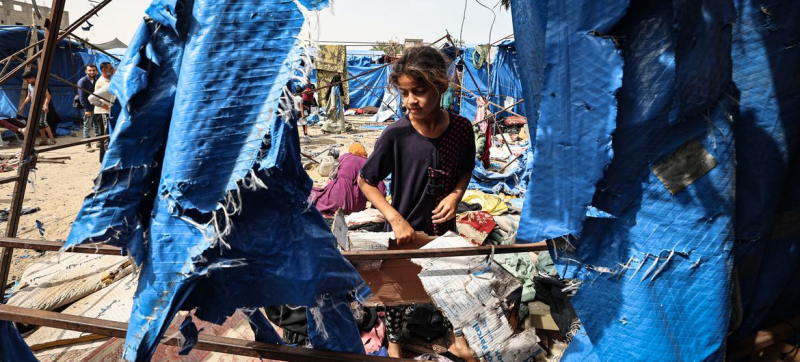- Trump considering military options on Greenland; Europe rejects |
- Fertiliser crunch threatens Kushtia’s onion boom despite high prices |
- Security Council Divided on United States' Venezuela Action |
- Over 1.53m voters register for postal balloting: Shafiqul Alam |
Gaza Civilians Face Deadly Choice: Shot or Fed at Aid Sites

A young girl visits her tent which was destroyed following airstrikes in Deir al-Balah, Gaza.
Following the deaths of several children in an Israeli strike on Palestinians waiting in line for nutritional supplements in central Gaza on Thursday, UN humanitarian officials have once again condemned the killings of people at aid distribution sites in the enclave.
UN Human Rights Office (OHCHR) spokesperson Ravina Shamdasani told reporters in Geneva on Friday, “We've raised concerns about atrocity crimes having been committed and the risk of further atrocity crimes, where people are lining up for essential supplies such as food and medicine and where they are being attacked. Again, they face a choice between being shot or being fed.”
“This is unacceptable, and it's continuing,” she deplored.
Ms Shamdasani said her office is still investigating the incident in which at least 15 Palestinians—including women and children—were reportedly killed by a strike in front of a clinic in Deir al-Balah, run by US-based aid group Project Hope, a partner of the UN Children’s Fund (UNICEF).
In a statement on Thursday, UNICEF chief Catherine Russell said the killing of families trying to access life-saving aid is “unconscionable.”
The Israeli military reportedly said it was targeting a Hamas member involved in the terror attacks in Israel on 7 October 2023.
Asked about the rationale of putting civilians, including children, in mortal danger when targeting a specific individual, Ms Shamdasani said that throughout the conflict in Gaza, OHCHR has expressed serious concerns about compliance with key principles of international humanitarian law, including distinction and proportionality.
“We have seen that a large proportion of the overall death toll in Gaza are women and children. Again, that raises serious questions about whether these principles are being respected,” she added.
Hungry people in Gaza face the risk of being shot while collecting food aid.
Killings of Gazans at or near aid distribution sites and around humanitarian convoys have become a regular occurrence amid severe restrictions on the entry of food, fuel, and relief items—especially since the establishment of food distribution sites bypassing the UN and operated by the Gaza Humanitarian Foundation (GHF).
Since late May, this militarised aid distribution model—backed by Israel and the United States—has sought to sideline the UN and its experienced humanitarian partners.
According to Ms Shamdasani, from 27 May to 7 July, OHCHR recorded 798 deaths, including 615 near GHF sites and 183 presumably along aid convoy routes.
Most of the nearly 800 deaths were “due to gunshot injuries,” said Ms Shamdasani.
Joining her in condemning the killings, World Health Organization (WHO) spokesperson Christian Lindmeier said he is “slowly lacking words to describe the scenario.”
“People are being shot at distribution sites… scores of women, children, men, boys, and girls are being killed while getting food, inside shelters, on roads to clinics, or inside clinics—this is far beyond unacceptable,” he said.
Commenting on the 75,000-litre fuel delivery into Gaza on Wednesday—the first such provision in over 130 days—Mr Lindmeier said: “As good as it is that this amount of fuel finally came in… we should not be relying on special news of special deliveries,” whether it be fuel, food, or other relief items.
“There should be regular deliveries into Gaza to keep lifelines open—to supply ambulances, hospitals, water desalination plants, bakeries—whatever is necessary to keep a bit of hope alive, to run the incubators,” he added.
The WHO spokesperson noted that 94 per cent of Gaza’s hospitals are now damaged or destroyed, while displacement continues and civilians are being pushed into ever-smaller spaces.
Mr Lindmeier expressed hope for a positive outcome in the ongoing ceasefire talks.
“Peace is the best medicine, and opening the doors remains the only viable option,” he concluded.

